This post may contain affiliate links. Please read the disclosure policy.
Experimenting with traditional Filipino dishes, to achieve that nostalgic taste from the days of my childhood is the best. I used to categorize Filipino foods as raisins or no raisins. Raisins I love but by themselves, in a trail mix or with a breakfast cereal. As a kid, I didn’t know all of different versions of the Filipino staple, pancit. I just loved eating all of them. I knew big noodles or little noodles, yellow noodles or white noodles, etc. The ones that we had on a regular basis were canton, bihon and palabok. I love the color and the flavor that the veggies in Canton and Bihon. Bihon is a great one to cook because you have more flexibility with cooking the veggies, versus the crispiness of blanching for Canton. I am excited to share my Delicious Pancit Bihon Recipe with you because it definitely takes me back.
As a kid, it seemed like there was a party to attend just about every other weekend. When it comes to parties, Filipino spared no expense. Parties were at one of the many halls throughout the Bay Area. There was always a DJ, mixing with vinyl records, blasting his latest cha-cha mix, party favorites and the latest in popular music. The DJ does get a break when one of the uncles performs his Engelbert Humperdinck or Elvis set. Yes, I miss those days.
What I miss the most about those parties is the massive array of food. Buffet style for 200 plus family members and friends and there was always still enough for people to take some home. Hopefully those days will come back soon. For now, you can perfect our Delicious Pancit Bihon Recipe, just in time for the next party.
Ingredients
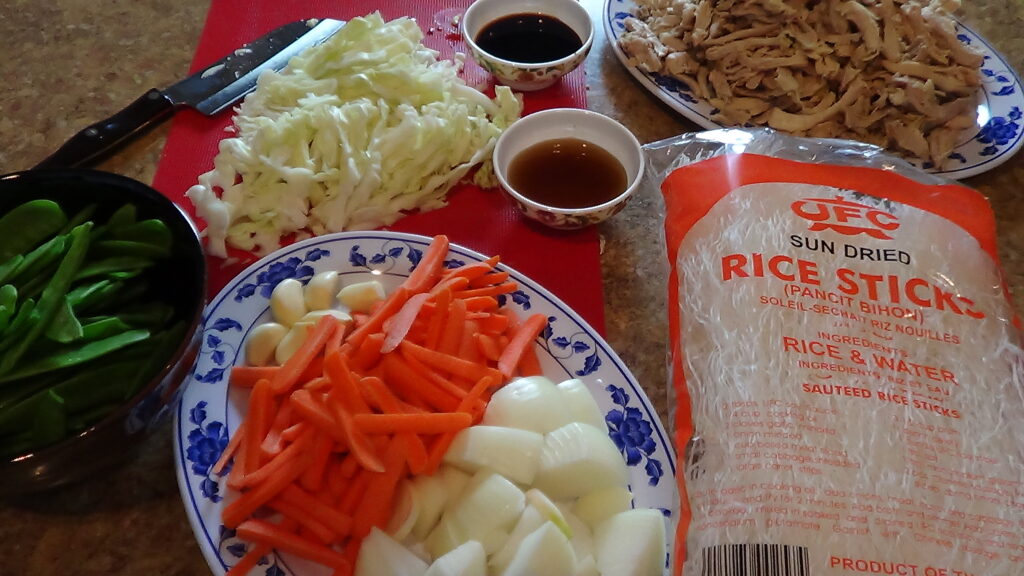
The obvious star of the show for Pancit Bihon is the Bihon noodles or stick noodles. At your local Asian markey, the Philippines aisle will more than likely have a good variety of Bihon noodle brands. I tend to stick with UFC or Tropics. Our recipe calls for the 16 oz package but it can easily be cut in half is you don’t want too much leftovers.
The rest is pretty simple. Your liquid contents will come mainly from water, but you will also have patis and soy sauce. My staple vegetables are carrots, snow peas, cabbage, onions and garlic. Green onions make a great garnish and don’t forget some calamansi to squeeze over your plate, before eating. Different types of mushrooms can also be added.
Our meat of choice if chicken. Other meats like shrimp or pork are great too but I make sure to include chicken because the broth that I make when cooking it is part of the recipe. You can get so much more flavor out of bone in thighs but to make the recipe easier, boneless and skinless thighs are perfect. You can go with other breasts but as I mentioned in other recipes, thighs are my go-to chicken parts.
Delicious Pancit Bihon Recipe Instructions
The Chicken
Other than the chicken prep, this recipe is fairly easy. As mentioned, you are going to need chicken broth and there is no better way to get it than by making it yourself. I recommend doing this step either the day before or well in advance. In 6 cups of water and tablespoon of salt, boil the chicken for 10 minutes. Again, the broth is for later so don’t throw it out. Remove chicken from pot and leave out to cool.
Once cool, you can now shred the chicken by hand. The chicken can be chopped but as shreds, your eating experience will be enhanced because it will have the same structure as the noodles, shredded cabbage, and the julienned carrots.
Veggie Prep
The onion is okay to chop because through the cooking process, it won’t have much of a structure or texture when bitten into. I like using my pestle and mortar to smash up my garlic, to release all of its oils before cooking. The carrots are julienned, cabbage shredded and the stem ends of the snow peas clipped.
Cooking
Before you get your heat going, place Bihon noodles in a large bowl for soaking. I give it a good rinse and drain to get rid of possible impurities, just like cooking rice. Fill up the bowl with water until noodles are completely immersed in the water. If you bowl is not big enough, you can push it down after being soaked for a few minutes. Soaking your noodles is important because it will remove excess starches before cooking.
In a large wok pan, add oil and sauté your chopped onion at a medium to medium high heat. Sautéing until transparent is not necessary. The onions will continue to cook throughout the process. After a few minutes of sautéing (5 minutes is fine), add chicken. Cook and stir well for another 5 minutes.
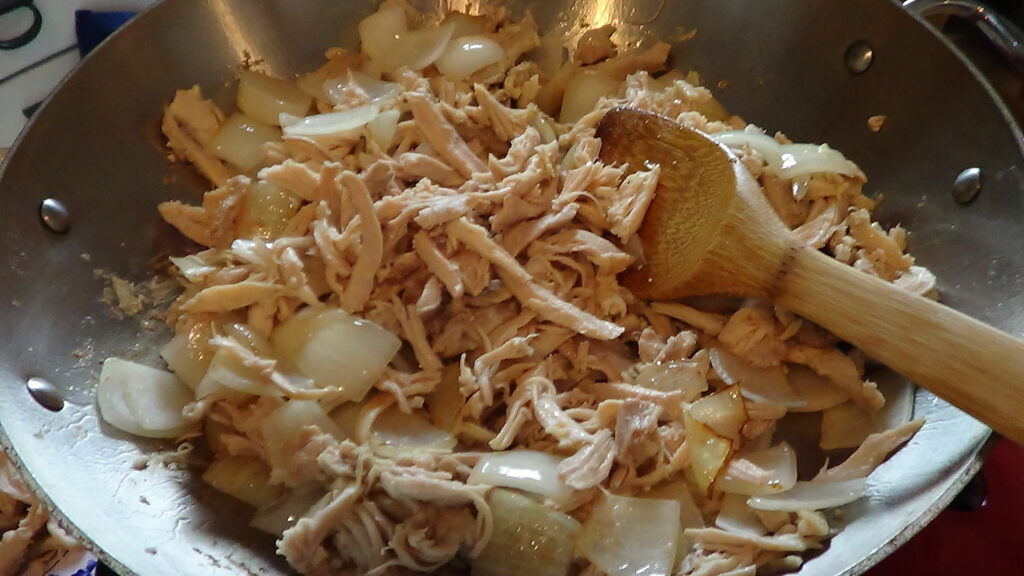
Bring In the Liquids
Pour in the chicken broth and turn your heat down to medium to medium low. This is when I like to add the soy sauce, patis, and garlic. The broth will help spread out the flavor of the three throughout the dish. While you are waiting for the broth to catch up to the heat, you can now go back to the Bihon noodles.

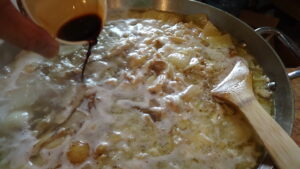
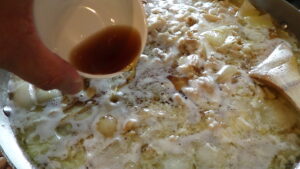
Drain the bowl of noodles well by pouring the water out and your hand holding the noodles back. At this point they should be pretty flexible. Don’t worry if there are little pieces flowing out of the bowl. You will have more than enough noodles.

Next part will go pretty fast so don’t walk off and check the news or text messages. If you’re broth is showing signs of simmering, go ahead and add your noodles to the pot, along with the pepper. It might look pretty soupy but I promise you that all of the broth will get soaked up into the noodles. The best way to mix everything is through a pinch and drop method. With tongs, gently (don’t break apart too many noodles) pick up the contents at the bottom of the plan and place it over the top. Continue rotating the ingredients and add your carrots. Before the majority of the broth gets soaked up, add your cabbage and continue mixing.
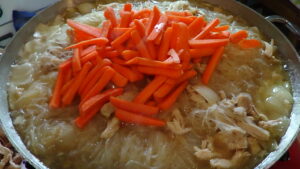
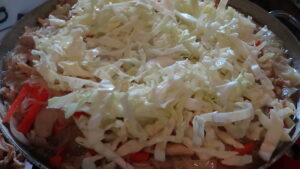
Mixing is important because you don’t want to get the noodles stuck at the bottom of the pan as you lose broth. When the broth is just about gone, but the noodles are still wet, you can turn your heat off and mix in your snow peas. Just don’t let it dry out. Allow the peas time to get cooked with just the temperature of the ingredients, before serving.
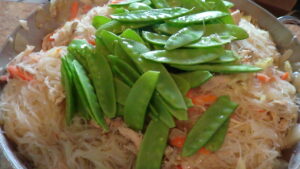
Get Ready to Eat
Don’t forget you slices of calamansi and as always, I hope that you didn’t forget to press the cook button on your rice cooker.
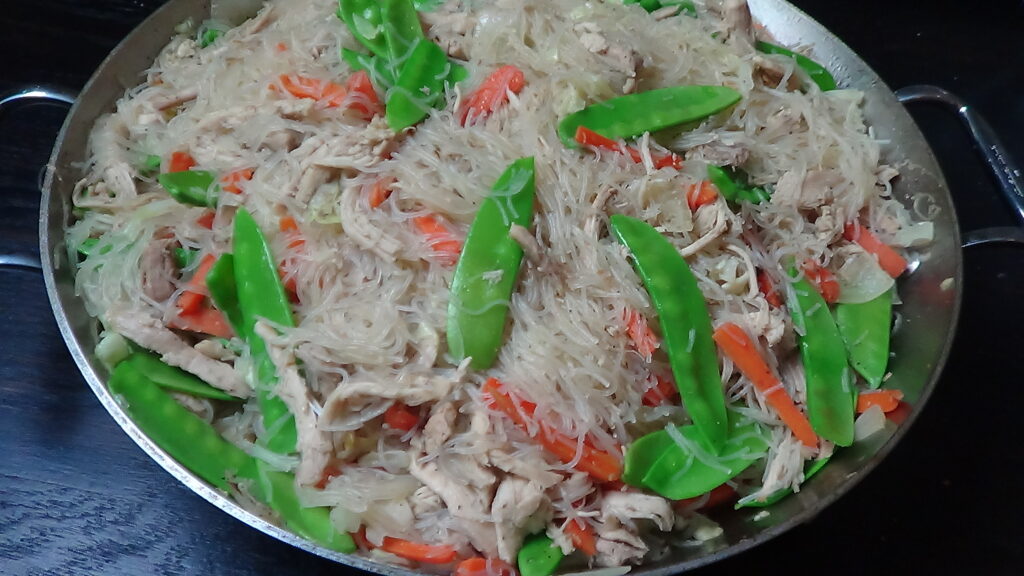
Enjoy and feel free to send us pictures of your Delicious Pancit Bihon Recipe!
Masayang Pagluluto!
Kain na tayo!
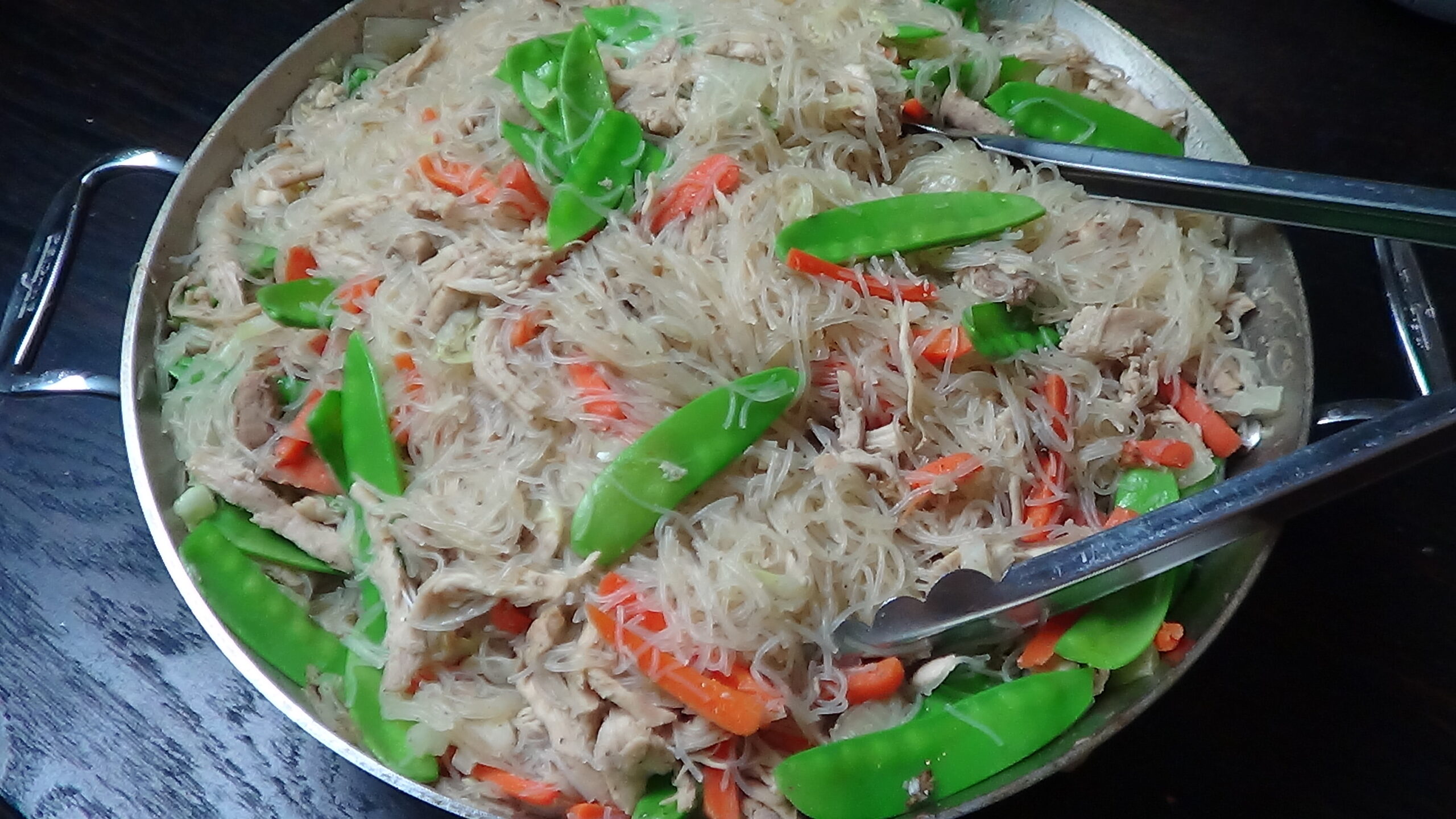
Delicious Pancit Bihon Recipe
Ingredients
- 3 lbs boneless skinless chicken thighs
- 1 Tbs salt
- 6 cup water
- 1 med onion chopped
- 2 cup carrots julienne cut
- 6 cloves garlic minced
- 3 cups snow peas ends trimmed off
- ¼ head cabbage
- 16 oz package of Bihon noodles
- 2 Tbs soy sauce
- 2 Tbs Patis
- 1 tsp ground black pepper
- cooking oil to coat bottom of pan
Instructions
- Boil chicken in water for 10 minutes.
- Remove chicken from broth and set broth aside and allow to cool.
- Once chicken is cooled, shred by hand.
- Wash and soak noodles in a large bowl for 10 minutes
- Coat bottom of pan with oil, set on Medium/ High heat, and saute onions.
- Add shredded chicken and mix.
- Pour broth in.
- Add garlic, soy sauce and mix well.
- Drain Bihon noodles.
- Once broth is simmering add noodles and mix.
- Add carrots and mix.
- Before broth is absorbed add cabbage, Patis, salt and pepper. Mix well.
- Once broth is absorbed but ingredients are still wet, turn off heat and add snow peas. Mix well.
- Allow peas to cook with the temperature of the ingredients before serving.

Pancit Bihon, my favorite Filipino noodle dish! For me, it’s all about the noodles and lots of it because leftovers are my favorite food. Where did those parties go?!? (One of my favorite lines to this day is “do you wanna go to a farty?! I laugh because mixing up my f’s and p’s is proof that I am Pinay after all. Believe it or not, I used to make my own version of pancit bihon and canton for my in-laws when we lived in England. It wasn’t authentic because I had to settle for English ingredients. But it was different and more importantly it impressed David’s family. They had no idea I could cook without a microwave oven! I tried making it once in the 25 years we’ve been back in the States and I’m grateful no one has charged me with food poisoning. Everyone at that dinner table was too polite to point out that the fresh noodles were actually rancid (as David pointed out, they weren’t Filipino so they wouldn’t know I was trying to poison them) but I knew and I was dying of embarrassment . The next day I returned the remaining noodles to Manila Oriental. I was so livid that I frightened the manager and immediately was given a refund. Your recipe however has given me hope that I can make edible pancit again! And, boy, can we use plenty of hope to get through the end of 2020.
Hope is what I bring! There’s a whole lot more of it too. I am glad that you tend to cook for very polite audiences. I suppose that you wouldn’t get away with that with a Filipino crowd. I vow to bring back the parties (farties) one day. It’ll be great. If anything, through 2020 that Manila Oriental manager has been thinking about your encounter as the “good ol’ days”
Out white friends are very polite – and still very much alive.
I used fresh noodles because I’m a very lazy cook and I tend to learn my lessons the hard way.
I forgot to mention that I enjoyed your categorization of Filipino food: raisins or no raisins. Our family was stingy with raisins when you compare our dishes to the offerings outside of our family farties (I promise that’s the last time I’ll use that word). The really bizarre thing is that now that I’m older, I look forward to those weird ingredients like raisins and vienna sausages in my embutido. Confession: when I was an ungrateful child, I disliked veggies so much that I would pick them out of my lumpia! Kuya Sedring made the best lumpia and the best kunow kunow. Sweet dreams are made of this…